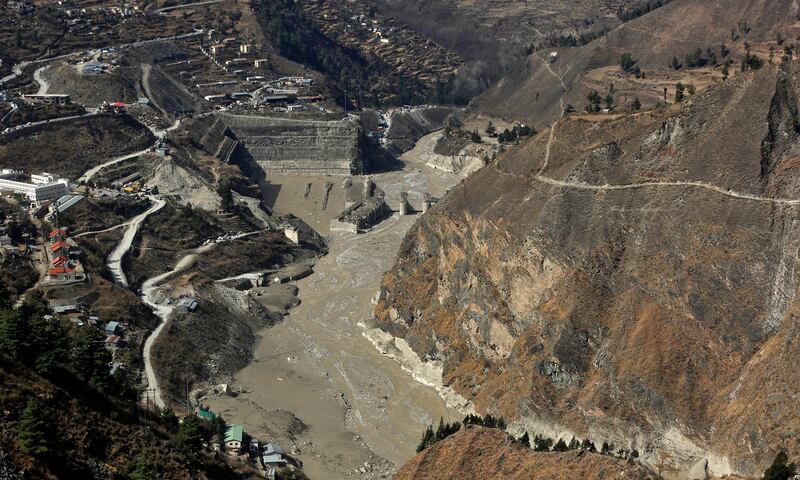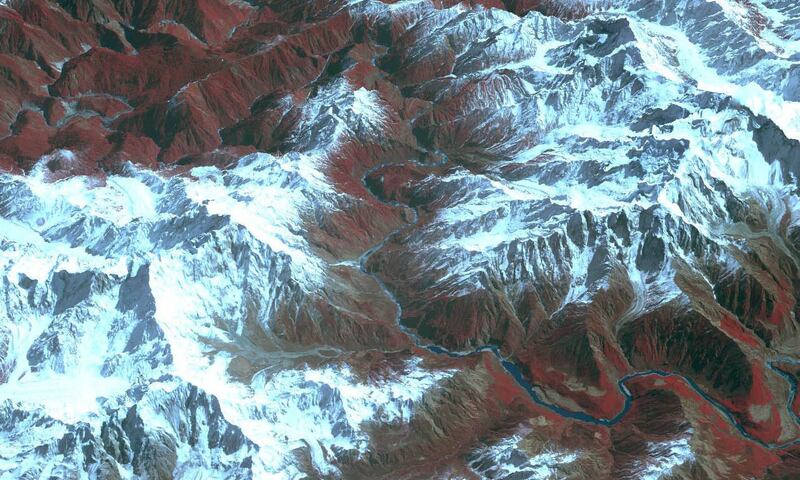The ruling Chinese Communist Party (CCP) this month gave the green light to a massive hydroelectric power project on the Yarlung Zangbo River in the Tibetan Autonomous Region, sparking concerns over potentially catastrophic environmental effects to come.
The project is now enshrined in the CCP's 14th Five-Year Plan and in the party's long-range objectives through 2035, following an annual meeting of the country's rubber-stamp parliament, the National People's Congress (NPC).
A source close to the design of the project told the CCP-run Global Times newspaper that the project will take the form of a cascade of power plants.
The paper quoted Yan Zhiyong, chairman of the Power Construction Corp of China, or POWERCHINA, as saying that the Yarlung Zangbo River project could provide 300 billion kilowatt-hours (kWh) of clean, renewable, and zero-carbon electricity annually.
But Indian scientists have warned that hydropower projects can lead to catastrophic consequences, citing the bursting of the Nanda Devi glacier in Uttarakhand in February 2021.
Around 150 workers at two hydroelectric dams in Tapovan-Reni were missing, believed dead, after being swept away in a torrent of water rushing down from the meltwater, with the power station and surrounding houses completely destroyed.

Germany-based engineer Wang Weiluo said China should be learning a lesson from India about the dangers of hydroelectric dams in the Himalayan region, where seismic changes are expected to the glacier-based ecosystem in the next few decades.
"As Indian scientists have said, there are two issues worthy of attention," Wang told RFA. "The first is that the glacier collapsed during the coldest time of year, although glaciers are more prone to collapse or rupture in summer and autumn."
"The second is that there is a link between rising [water] temperatures [leading to meltwater build-up] and the large number of hydroelectric dams that have been built on the southern slopes of the Himalayas," he said.
The Qinghai-Tibet Plateau is the seat of the Hindu Kush-Himalayan ice sheet, an area that has been called the Third Pole.
It contains around 15 percent of the world's snow and ice, the largest quantity outside of the Arctic and Antarctica, but there has been dramatic shrinkage in recent years as it absorbs energy caused by global heating.
Entire region unstable
Wang Chung-ho, a researcher at the Institute of Earth Sciences at Taiwan's Academia Sinica, said the entire region is now unstable due to global heating, making glacier-related disasters even more likely in future.
"Glaciers in the Himalayas are receding at a rate of 10 to 15 meters per year right now," Wang Chung-ho said. "The amount of ice melting has doubled in the last 20 years compared with the previous 20 years."
"As the glaciers melt and disappear, the surrounding population will also increase, with hundreds of millions of people in India, China, Nepal, and other countries facing dangerous water shortages," he said.
He said glaciers on Mount Everest and surrounding areas have shrunk by 13 percent in the past 50 years, and the snowline has risen by nearly 200 meters.
Wang Weiluo said Tibet is already experiencing the effects of global heating.
“In 2016, there were two glacier collapses in the Ngari region of Tibet on the northern side of the Himalayas, and the scale was much larger than the Indian incident.” he said. "And the glaciers of the Ngari region were considered among the most stable by Chinese scientists."
Earlier this year, the Chinese Academy of Sciences published a study in the international journal "The Cryosphere" saying that the Ngari glacier collapses had released 150 million cubic meters of ice and water into downstream areas between 2016 and 2019, boosting water levels in Lake Manasarovar by 23 percent.
"As glaciers melt, many glacial lakes will appear downstream," Wang Chung-ho predicted. "New glacial lakes will be formed, and the area of the existing glacial lakes will expand."
He said international experts have been using satellite photos to analyze the Himalayan regions near the borders of China, Nepal, and India, and have found 3,624 glacial lakes, of which 47 are considered extremely dangerous.
"They are very likely to burst their banks and cause flooding in downstream areas. They are disasters waiting to happen," Wang Chung-ho said.

Huge threat to dams
Glacier bursts and lake overflows pose a huge threat to hydroelectric dams, Wang Weiluo said.
"Many reservoirs in Tibet are directly downstream of glaciers, and they rely on glacier meltwater," he said. “Manla reservoir on the Nianchu river, a tributary of the Yarlung Zangbo River, has about 83 glaciers upstream of it, 130 square kilometers in total."
He said a glacier had slid down the river valley in 1954, causing "many casualties."
"The speed and energy of the glacier sliding down was much stronger than any dam-breaking flood," Wang Weiluo said.
He said the pace of reservoir and dam-building in the region has nonetheless been frenetic, with 100 small reservoirs, 11 medium-sized reservoirs, and 10 large-scale reservoirs in high risk areas.
Despite the risks, China's State Development and Reform Commission has vowed to press ahead with the development of hydropower in the lower reaches of the Yarlung Zangbo River, a project that will have three times the capacity of the massive and controversial Three Gorges hydroelectric power project on the Yangtze River.
Wang Weiluo also cited fragile ecosystems and seismic instability in the region as good reasons not to push ahead with the project, in the face of likely opposition from India, which like Bangladesh, refers to the Yarlung Zangbo as the Brahmaputra River.
He said China is already building two hydroelectric dams on the river at Zangmu. In addition, construction is under way at a hydroelectric power station on the Jinsha river, as well as several hydroelectric dams on the Lancang River.
He said the 14th Five-Year Plan also contains plans to develop the Nu River in Tibet, the only river that still has no dams on it at all.
Thinning rate doubles
Meanwhile, Wang Chung-ho said the sheer force and energy of glacier bursts and collapses exceeds maximum safety specifications of dams that are currently in operation.
In June 2019, research published by Columbia University and the University of Utah showed that the rate at which glaciers in the Himalayan region are thinning doubled between 2000 to 2016, from 0.25 meters a year to 0.5 meters annually.
At this rate, there will be no glaciers left in the Himalayas by the end of the century, Wang Weiluo said.
Chinese scientists have also concluded that the Qinghai-Tibet plateau is heating up twice as fast as glaciers elsewhere in the world, he said.
While the melting of glaciers will initially boost water levels in lakes and rivers, this process isn't sustainable, and will eventually result in dry riverbeds, Wang Weiluo said.
Wang Chung-ho cited climate scientists as saying that the Earth has absorbed energy from global heating equivalent to five Hiroshima atomic bombs per second since the Industrial Revolution.
"These are alarming and terrifying numbers," he said.
Reported by Mai Xiaotian for RFA's Mandarin Service. Translated and edited by Luisetta Mudie.
